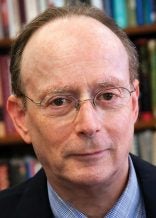Though Simchat Torah is designated as the Festival of Joy, for a long time my mother considered it one of the saddest days of the year for her. That’s because there were many times when our small Orthodox congregation in Annapolis, Md., where my father was the rabbi, had trouble keeping a minyan together for that holiday service, highlighted by the hakafot, the seven rounds of dancing with the Torah scrolls.
My mom remembered the excitement of celebrating the holiday in her youth when her father was the rabbi of a large congregation in Baltimore, and crowds of people would mark the day with spirit — and spirits — since making a “L’chaim” was part of the experience, at least for the men in attendance.
But Annapolis when I was growing up in the 1950s and ’60s was a different story. On the night Simchat Torah began, families would come to the only shul in town and children would march, wave special holiday flags and enjoy fruits and sweets. But the next morning, in sharp contrast, there was usually a struggle to corral a quorum of 10 men for the minyan. Only a handful of congregants in the community were observant, and most members resumed their daily routine on Simchat Torah — a work day for the men, school for the kids. (And women weren’t a significant presence in those days.) Among the few men who came to services on the holiday, most were in a hurry, no doubt planning to go to their businesses or offices after shul.
Some were there to say Kaddish, and were used to normal weekday services taking a half-hour or so. A full Simchat Torah service could run close to three hours, with the Hallel and other festival prayers, and extended hakafot before reading the last verses of Deuteronomy marking the death of Moses, and then starting the annual Torah-reading cycle again with the opening chapter of Genesis, describing God’s creation of the world.
There were times, I recall, when a congregant or two on Simchat Torah morning would give my dad a kind of ultimatum, telling him what time they planned to leave. So in order to maintain the quorum, the service was speeded up, the hakafot were abbreviated and the singing and dancing were minimal. We were racing against the clock, and the mood was more of urgency than exuberance.
I could see tears in my mom’s eyes when we came home. She and my dad worried about raising my brother and me outside of a vibrant Jewish community, and about the future of traditional Jewish life in America. A bland Simchat Torah service seemed to symbolize what we were missing.
All those memories came to mind the other night, on Simchat Torah, when my wife and I, spending the holiday with family in Manhattan, experienced the full force of an Upper West Side Simchat Torah. The services we attended were packed, long (unrushed) and joyful, both in the evening and again the next morning, and the city streets were filled with adults and kids doing the Shul Shuffle, as we did, taking in the experience at a variety of congregations.
A key destination for many is B’nai Jeshurun (BJ), the innovative non-denominational congregation on West 88th Street, whose blend of low-key music and high-spirited, jubilant dancing each year draws thousands. The line outside the synagogue on Simchat Torah night can snake around the block with so many young people — teens, 20s and 30s — eagerly awaiting entrance, monitored by security guards, that you’d think you were witnessing a major rock event.
Inside the 100-year-old, vast sanctuary, the place was pulsing with music and dancing for hours. How my mother would have loved this scene, I thought, even as I wondered if this was just a rare connection to ritual for many here — a Jewish rave. It brought to mind the vision I had of the thousands of young Jews who, otherwise cut off from their Judaism during the reign of the Soviet Union, would gather outside the Great Synagogue in Moscow once a year, on the night of Simchat Torah, in celebration of their heritage and defiance of the Communist authorities.
In those days, we feared for the Jewish future of those whose religious freedoms were denied them; today, with unprecedented freedom, we worry about the Jewish future of young people who will choose to opt out of religious life. But taking in the scene at BJ, and reflecting on so many vibrant congregations around the country, we sense a Jewish renaissance that is taking place even as so many of our people are distancing themselves from their traditions and rituals. This is not a new phenomenon. Jewish history has always been about the ebb and flow, the shifts toward and away from the ancient teachings and the resilience of an ever-dying people that manages to renew itself in each generation, adapting to the times.
Eight years ago, my mom chose to spend Simchat Torah in the same synagogue in Annapolis where she served as rebbetzin for 64 years, happy to be with multiple generations of worshippers and friends who mourned her sudden passing four days later. But she had lived to see the fruit of her efforts blossom in family and fellow congregants. And on that Simchat Torah, as the scrolls were returned to the ark, she sang as they did: “It is a tree of life to those who hold fast to it, and all who uphold it are happy.”
May her memory be a blessing.
The New York Jewish Week brings you the stories behind the headlines, keeping you connected to Jewish life in New York. Help sustain the reporting you trust by donating today.





